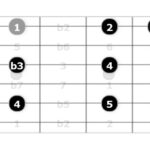Unlocking the Guitar Fretboard is fundamental to becoming a proficient guitar player. The fretboard is essentially the map of your guitar, showing you where each note is located. Understanding this layout is crucial for learning songs, writing music, improvising, and truly connecting with your instrument. This guide will help you visualize and navigate the guitar fretboard effectively, enhancing your musical journey.
Understanding the Guitar Fretboard Layout
When you look at the guitar fretboard, visualize it as if you are holding the guitar in playing position. In standard tuning, the thickest string at the top is the low E string (6th string), and the thinnest string at the bottom is the high E string (1st string). The frets are numbered starting from the nut (closest to the headstock) upwards towards the guitar body. The 12th fret is often marked with a double dot or other inlay, indicating the octave.
The fretboard diagram above represents this perspective, mirroring what you see when you play. This orientation makes it intuitive to find notes and understand musical patterns across the neck of the guitar.
Exploring Different Guitar Tunings on the Fretboard
While standard tuning (E A D G B E) is the most common tuning for guitar, many musical styles utilize alternative tunings to achieve different sounds and playing techniques. These tunings alter the pitch of the strings, consequently changing the notes on the fretboard. Some popular alternative tunings include:
- DADGAD: Known for its open and resonant sound, often used in folk and Celtic music.
- Drop D: Lowers the 6th string to D, providing a heavier, lower sound, popular in rock and metal.
- Open G: Tuned to a G major chord, favored in blues and slide guitar.
- Drop C: Lower tuning used in heavier genres, creating a darker and more aggressive tone.
- Open C: Tuned to a C major chord, offering a bright and resonant open tuning.
Understanding how different tunings affect the fretboard is key to versatility and exploring new sonic landscapes on your guitar. Experimenting with tunings can open up new creative avenues and inspire unique musical ideas. For a comprehensive overview of various tunings, explore our guitar tuning chart.
Interactive Fretboard Features for Enhanced Learning
Visualizing the fretboard is made easier with interactive tools. Features like highlighting specific notes or scales on a virtual fretboard can significantly aid in learning and memorization. Being able to hear the sound of individual notes, using different guitar tones such as electric, acoustic, or nylon, provides auditory reinforcement to your visual learning. Furthermore, options to switch to a left-handed fretboard cater to all players, ensuring accessibility for everyone.
To further your guitar learning journey, consider exploring related resources such as our guitar scales tool for practicing scales, the guitar chords tool for chord diagrams, and the online tuner to keep your guitar perfectly in tune. For bass and ukulele players, we also offer dedicated fretboard resources: bass fretboard and ukulele fretboard.
Why Visualize the Fretboard? Unlocking Musical Potential
Visualizing the guitar fretboard is not just about knowing where the notes are; it’s about unlocking your musical potential. A strong understanding of the fretboard allows you to:
- Quickly locate any note: Essential for sight-reading, learning songs, and transcribing music.
- Apply music theory concepts: Visualize scales, chords, and intervals directly on your instrument.
- Improvise with confidence: Navigate the fretboard fluidly and express your musical ideas freely.
- Compose and write songs: Understand the relationships between notes and chords, facilitating songwriting.
- Learn more efficiently: Connect visual patterns with auditory feedback, accelerating your learning process.
By mastering the guitar fretboard, you gain a deeper connection with your instrument and unlock a world of musical possibilities.
Conclusion: Embrace the Fretboard and Elevate Your Guitar Playing
The guitar fretboard is your playground for musical exploration. By taking the time to visualize and understand its layout, you are investing in a skill that will pay dividends throughout your guitar playing journey. Utilize the interactive tools available, experiment with different tunings, and most importantly, practice visualizing the fretboard regularly. Start exploring the fretboard today and witness the transformation in your guitar playing. Don’t forget to check out our other helpful guitar tools on guitarplayers.net to continue expanding your musical toolkit!

